22.11.2023
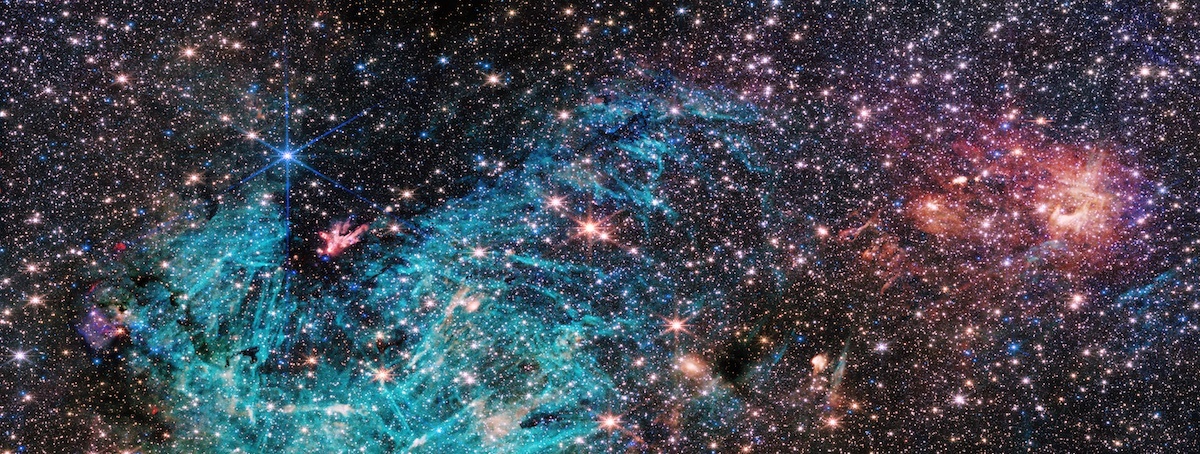
The latest image from NASA’s James Webb Space Telescope shows a portion of the dense center of our galaxy in unprecedented detail, including never-before-seen features astronomers have yet to explain. The star-forming region, named Sagittarius C (Sgr C), is about 300 light-years from the Milky Way’s central supermassive black hole, Sagittarius A*.
Image: Sagittarius C (NIRCam)
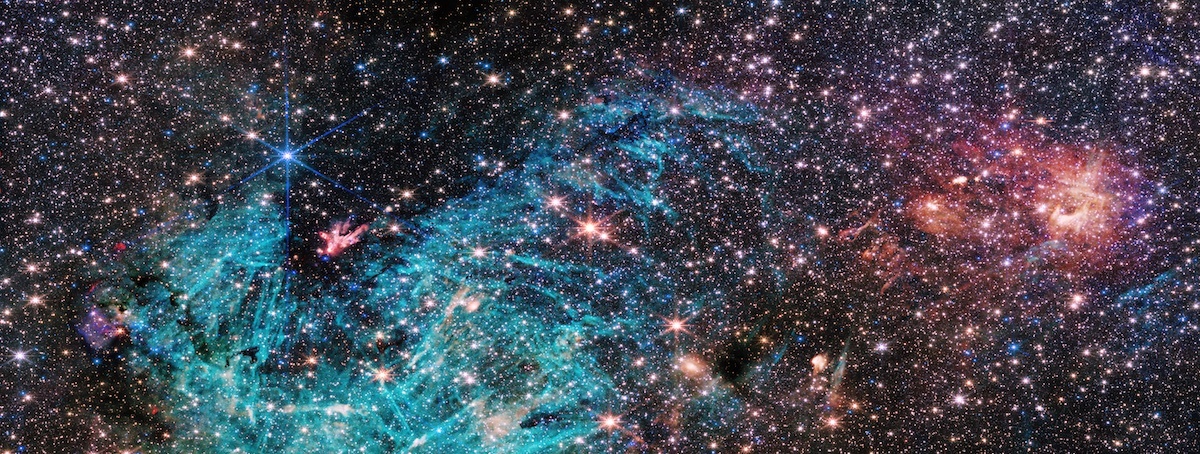
“There’s never been any infrared data on this region with the level of resolution and sensitivity we get with Webb, so we are seeing lots of features here for the first time,” said the observation team’s principal investigator Samuel Crowe, an undergraduate student at the University of Virginia in Charlottesville. “Webb reveals an incredible amount of detail, allowing us to study star formation in this sort of environment in a way that wasn’t possible previously.”
“The galactic center is the most extreme environment in our Milky Way galaxy, where current theories of star formation can be put to their most rigorous test,” added professor Jonathan Tan, one of Crowe’s advisors at the University of Virginia.
Protostars
Amid the estimated 500,000 stars in the image is a cluster of protostars – stars that are still forming and gaining mass – producing outflows that glow like a bonfire in the midst of an infrared-dark cloud. At the heart of this young cluster is a previously known, massive protostar over 30 times the mass of our Sun. The cloud the protostars are emerging from is so dense that the light from stars behind it cannot reach Webb, making it appear less crowded when in fact it is one of the most densely packed areas of the image. Smaller infrared-dark clouds dot the image, looking like holes in the starfield. That’s where future stars are forming.
Webb’s NIRCam (Near-Infrared Camera) instrument also captured large-scale emission from ionized hydrogen surrounding the lower side of the dark cloud, shown cyan-colored in the image. Typically, Crowe says, this is the result of energetic photons being emitted by young massive stars, but the vast extent of the region shown by Webb is something of a surprise that bears further investigation. Another feature of the region that Crowe plans to examine further is the needle-like structures in the ionized hydrogen, which appear oriented chaotically in many directions.
“The galactic center is a crowded, tumultuous place. There are turbulent, magnetized gas clouds that are forming stars, which then impact the surrounding gas with their outflowing winds, jets, and radiation,” said Rubén Fedriani, a co-investigator of the project at the Instituto Astrofísica de Andalucía in Spain. “Webb has provided us with a ton of data on this extreme environment, and we are just starting to dig into it.”
Image: Sagittarius C Features
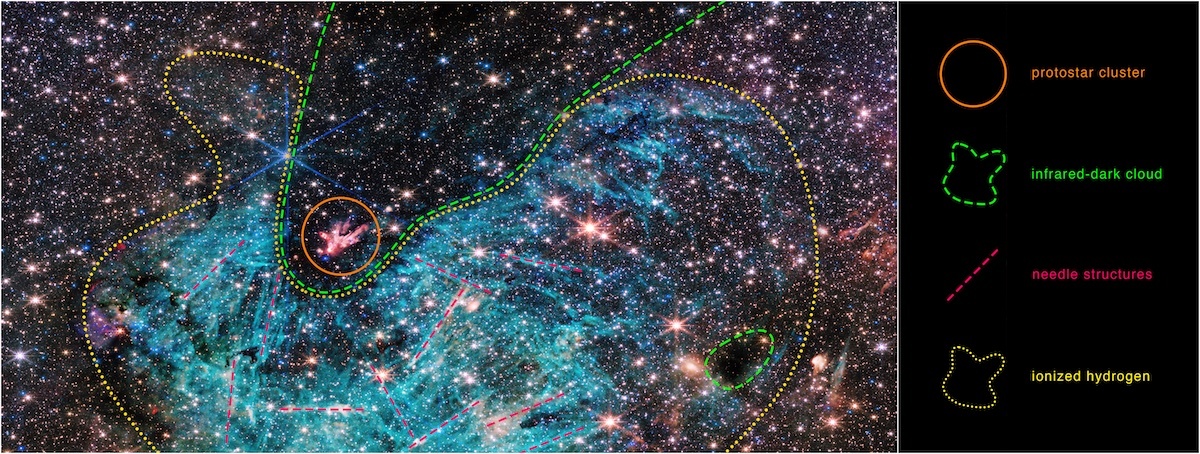
Around 25,000 light-years from Earth, the galactic center is close enough to study individual stars with the Webb telescope, allowing astronomers to gather unprecedented information on how stars form, and how this process may depend on the cosmic environment, especially compared to other regions of the galaxy. For example, are more massive stars formed in the center of the Milky Way, as opposed to the edges of its spiral arms?
“The image from Webb is stunning, and the science we will get from it is even better,” Crowe said. “Massive stars are factories that produce heavy elements in their nuclear cores, so understanding them better is like learning the origin story of much of the universe.”
The James Webb Space Telescope is the world’s premier space science observatory. Webb is solving mysteries in our solar system, looking beyond to distant worlds around other stars, and probing the mysterious structures and origins of our universe and our place in it. Webb is an international program led by NASA with its partners, ESA (European Space Agency) and the Canadian Space Agency.
Quelle: NASA
----
Update: 23.11.2023
.
James Webb Space Telescope discovers 'Cosmic Vine' of 20 connected galaxies in the early universe
The James Webb Space Telescope has discovered a massive chain of 20 galaxies in the early universe, raising questions about the formation of the largest structures in the cosmos.
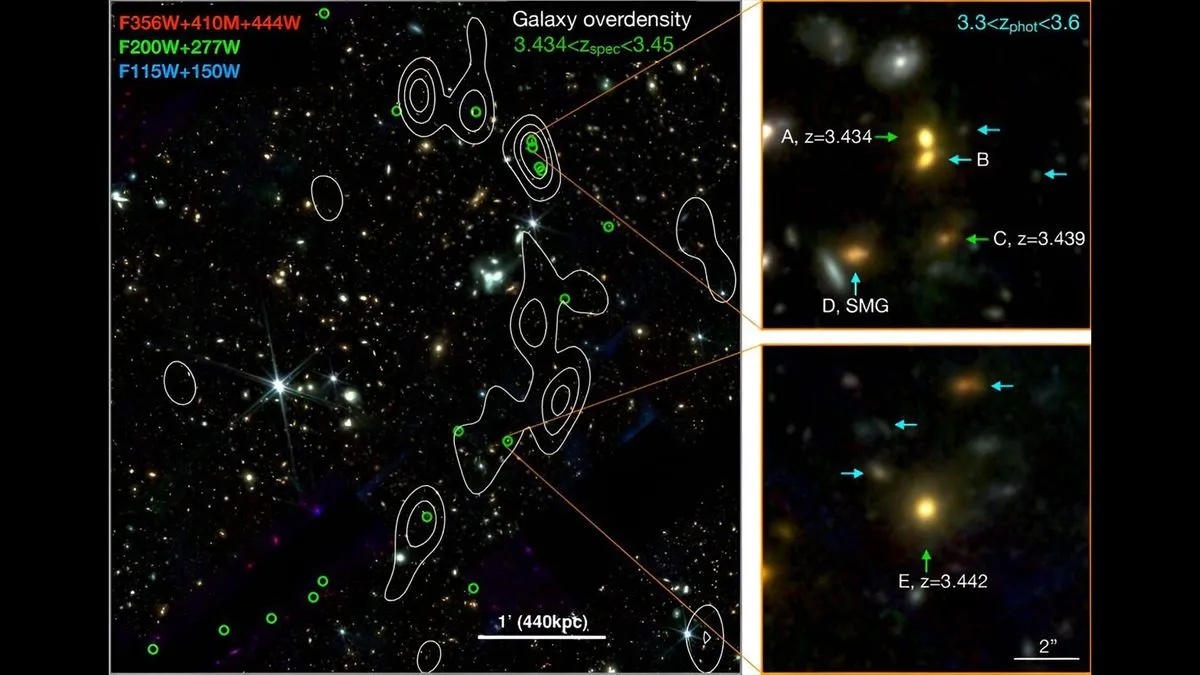
JWST color-composed image of the Cosmic Vine. (Image credit: arXiv)
Astronomers using James Webb Space Telescope (JWST) data have discovered a massive chain of at least 20 closely packed galaxies from the early universe, and it could reveal insight into how the most massive structures in the cosmos form.
This megastructure — nicknamed the "Cosmic Vine" in a study published Nov. 8 to the preprint database arXiv — swoops through space in a bow shape, estimated to stretch more than 13 million light-years long and about 650,000 light-years wide. (For comparison, our Milky Way galaxy is about 100,000 light-years wide.) Astronomers detected the vast tendril of gas and galaxies while studying James Webb Space Telescope observations of an area called the Extended Groth Strip, located between the constellations Ursa Major and Boötes.
The team was looking specifically for light from very early galaxies, focusing on a property called redshift, a measure of how light increases in wavelength as it travels vast distances through the expanding universe. All of the galaxies observed in the Cosmic Vine showed a redshift of roughly 3.44, meaning the light emitted by the objects traveled between 11 billion and 12 billion years — or for most of our 13.8 billion-year-old universe's lifetime — before reaching JWST's lens.
The Cosmic Vine is "significantly larger" than other galaxy groups observed so early in the universe's history, the team wrote, adding it to a growing list of surprisingly huge structures in the early universe discovered by JWST. According to the researchers, the Vine appears to be on its way to becoming a galaxy cluster; these are the most massive structures in the universe bound together by gravity, with masses typically ranging from hundreds of billions to quadrillions of times the mass of the sun.
For now, the Cosmic Vine has an estimated mass of about 260 billion solar masses and is still growing — but its two largest galaxies may be ready to call it quits. While studying the wavelengths of light emitted by the two galaxies, the researchers found that star formation has all but stopped there, designating them as "quiescent" or "quenched" galaxies.
The authors pondered, what is "the culprit quenching star formation" at such an early cosmic time? They noted that it is unusual to find such large galaxies already running low on star-forming gas in the ancient universe. One possibility is that both galaxies are the results of recent galactic mergers, with cosmic collisions triggering wild bursts of star formation that depleted most of the galaxies' available gas about half a billion years before JWST's observations, the researchers wrote.
As with many recent JWST discoveries, the Cosmic Vine raises more questions about the nature of our universe than it answers, and further study is needed to solve the mysteries locked behind this ancient galactic chain.
James Webb Space Telescope observes methane in exoplanet's atmosphere
Discovery promises better understanding of atmospheric composition in cooler planets
NASA’s James Webb Space Telescope (JWST) has observed the planet WASP-80 b, as it passed in front of and behind its host star, revealing spectra indicative of an atmosphere containing methane gas and water vapor.
While water vapor has been detected in over a dozen planets, until recently, methane — a molecule abundantly found in the atmospheres of Jupiter, Saturn, Uranus and Neptune within our solar system — has remained elusive in the atmospheres of transiting exoplanets when studied with space-based spectroscopy.
Arizona State University scientists Luis Welbanks and Michael Line, of the School of Earth and Space Exploration, along with Taylor Bell from the Bay Area Environmental Research Institute (BAERI), have been studying WASP-80 b and the significance of JWST discovering methane in exoplanet atmospheres. Their findings have been recently published in Nature.
With a temperature of about 825 kelvins (1,025 degrees Fahrenheit), WASP-80 b is what scientists call a “warm Jupiter” — or a planet that is similar in size and mass to the planet Jupiter but has a temperature that’s in between that of "hot Jupiters," like the 1,450 kelvins (2,150 F) HD 209458b exoplanet, and "cold Jupiters," like our own, which is about 125 kelvins (-235 F).
WASP-80 b goes around its red dwarf star once every three days and is situated 163 light-years away from us in the constellation Aquila. Because the planet is so close to its star and both are so far away from us, spotting the planet separately from its star would be like trying to see a single strand of hair from 9 miles away. Therefore, we can't see the planet directly with even the most advanced telescopes like JWST, and instead researchers study the combined light from the star and planet using methods like the transit method, which has been used to discover most known exoplanets, or the eclipse method.
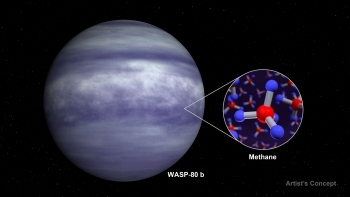
An artist's rendering of the warm exoplanet WASP-80 b whose color may appear bluish to human eyes due to the lack of high-altitude clouds and the presence of atmospheric methane identified by NASA’s James Webb Space Telescope, similar to the planets Uranus and Neptune in our own solar system. Image credit: NASA.
"This was the first time we had seen such an obvious methane spectral feature with our eyes in a transiting exoplanet spectrum, not too much unlike what could be seen in the spectra of the solar system giant planets a half a century ago,” said Welbanks, who is a NASA Hubble Fellow at ASU's School of Earth and Space Exploration.
"Using the transit method, we observed the system when the planet moved in front of its star from our perspective, causing the starlight we see to dim a bit," he said. "It’s kind of like when someone passes in front of a lamp and the light dims. During this time, a thin ring of the planet’s atmosphere around the planet’s day/night boundary is lit up by the star, and at certain colors of light where the molecules in the planet’s atmosphere absorb light, the atmosphere looks thicker and blocks more starlight, causing a deeper dimming compared (with) other wavelengths where the atmosphere appears transparent. This method helps scientists like us understand what the planet’s atmosphere is made of by seeing which colors of light are being blocked."
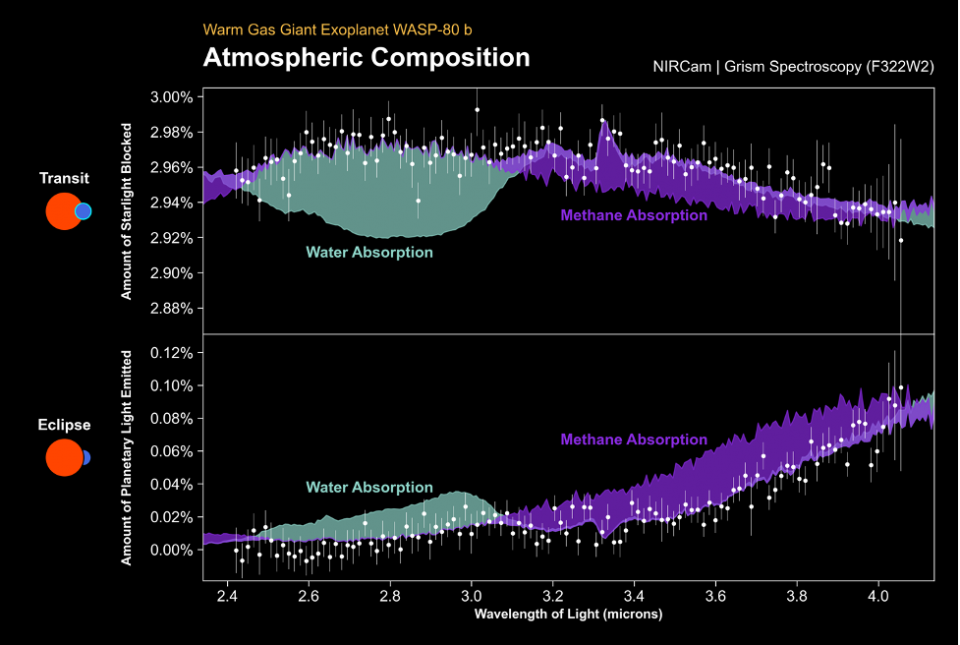
The measured transit spectrum (top) and eclipse spectrum (bottom) of WASP-80 b from NIRCam’s slitless spectroscopy mode on NASA's James Webb Space Telescope. In both spectra, there is clear evidence for absorption from water and methane whose contributions are indicated with colored contours. During a transit, the planet passes in front of the star, and in a transit spectrum, the presence of molecules makes the planet's atmosphere block more light at certain colors, causing a deeper dimming at those wavelengths. During an eclipse, the planet passes behind the star, and in this eclipse spectrum, molecules absorb some of the planet’s emitted light at specific colors, leading to a smaller dip in brightness during the eclipse compared to a transit. Image Credit: BAERI/NASA/Taylor Bell.
Meanwhile, using the eclipse method, the research team observed the system as the planet passed behind its star from Earth's perspective, causing another small dip in the total light received.
All objects emit some light, called thermal radiation, with the intensity and color of the emitted light depending on how hot the object is. Just before and after the eclipse, the planet’s hot dayside is pointed toward Earth, and by measuring the dip in light during the eclipse, researchers were able to measure the infrared light emitted by the planet.
For eclipse spectra, absorption by molecules in the planet’s atmosphere typically appears as a reduction in the planet’s emitted light at specific wavelengths. Also, since the planet is much smaller and colder than its host star, the depth of an eclipse is much smaller than the depth of a transit.
The initial observations the team made need to be transformed into something we call a spectrum; this is essentially a measurement showing how much light is either blocked or emitted by the planet’s atmosphere at different colors (or wavelengths) of light. Many different tools exist to transform raw observations into useful spectra, and sometimes different tools give different results, so they used two different approaches to make sure their findings were robust to different assumptions.
Next, the team interpreted this spectrum using two kinds of models to simulate what the atmosphere of a planet under such extreme conditions would look like. The first type of model is entirely flexible, trying millions of combinations of methane and water abundances and temperatures to find the combination that best matched their data.
The second type, called "self-consistent models," also explores millions of combinations but uses existing knowledge of physics and chemistry to determine the levels of methane and water that could be expected. Both model types reached the same conclusion: a definitive detection of methane.
"Before JWST, methane had remained largely undetected, despite expectations that it could have been detected with Hubble Space Telescope in planets where it should have been abundant. These lack of detections generated a flurry of ideas ranging from the intrinsic depletion of carbon to its photochemical destruction to the mixing of deep methane depleted gas," Line said.
To validate their findings, the researchers used robust statistical methods to evaluate the probability of their detection being random noise. In the astronomy field, astronomers regard 5-sigma detections as the "gold standard," meaning the odds of a detection being caused by random noise are one in 1.7 million.
Meanwhile, Welbanks and Bell detected methane at 6.1-sigma in both the transit and eclipse spectra, which sets the odds of a spurious detection in each observation at one in 942 million, surpassing the 5-sigma "gold standard" and reinforcing their confidence in both detections.
With such a confident detection, not only did the researchers find a very elusive molecule, but they will now start exploring what this chemical composition tells us about the planet’s birth, growth and evolution.
"Methane is important as it is the main carbon reservoir in cooler (less than 1,000 K) giant planets, much like our own solar system giants, Jupiter and Saturn. If we want to understand atmospheric composition and chemistry in these cooler regimes, detecting and constraining the abundance of methane is absolutely essential,” says Line, associate professor at the School of Earth and Space Exploration.
For example, by measuring the amount of methane and water in the planet, researchers can infer the ratio of carbon atoms to oxygen atoms. This ratio is expected to change depending on where and when planets form in their system. Thus, examining this carbon-to-oxygen ratio can offer clues as to whether the planet formed close to its star or further away before gradually moving inward.
Another thing that has Welbanks, Bell and the team excited about this discovery is the opportunity to finally compare planets outside of our solar system to those in it.
NASA has a history of sending space probes to the gas giants in our solar system to measure the amount of methane and other molecules in their atmospheres. Now, by having a measurement of the same gas in an exoplanet, researchers can start to perform an “apples-to-apples” comparison and see if the expectations from the solar system match what they see outside of it.
Finally, as scientists look toward future discoveries with JWST, this result reveals that they are at the brink of more exciting findings.
Additional MIRI and NIRCam observations of WASP-80 b with JWST will allow scientists to probe the properties of the atmosphere at different wavelengths of light. The findings from this international group of researchers led them to think that they will be able to observe other carbon-rich molecules, such as carbon monoxide and carbon dioxide, enabling them to paint a more comprehensive picture about the conditions in this planet’s atmosphere.
Additionally, as more methane and other gases in exoplanets are observed, scientists like Welbanks, Line and Bell will continue to expand their knowledge about how chemistry and physics work under conditions unlike what we have on Earth, and maybe sometime soon, in other planets that remind us of what we have here at home.
"Not only is methane an important gas in tracing atmospheric composition and chemistry in giant planets, it is also hypothesized to be, in combination with oxygen, a possible signature of biology. One of the key goals of the Habitable Worlds Observatory, the next NASA flagship mission after JWST and Roman, is to look for gases like oxygen and methane in Earth-like planets around sun-like stars,” Welbanks said.
“Understanding the physical processes that dictate its presence over a broad range of planetary conditions will be critical to providing context to these future observations."
Quelle: Arizona State University
----
Update: 30.11.2023
.
Webb Telescope: A prominent protostar in Perseus
This new Picture of the Month from the NASA/ESA/CSA James Webb Space Telescope reveals intricate details of the Herbig Haro object 797 (HH 797). Herbig-Haro objects are luminous regions surrounding newborn stars (known as protostars), and are formed when stellar winds or jets of gas spewing from these newborn stars form shockwaves colliding with nearby gas and dust at high speeds. HH 797, which dominates the lower half of this image, is located close to the young open star cluster IC 348, which is located near the eastern edge of the Perseus dark cloud complex. The bright infrared objects in the upper portion of the image are thought to host two further protostars.
This image was captured with Webb’s Near-InfraRed Camera (NIRCam). Infrared imaging is powerful in studying newborn stars and their outflows, because the youngest stars are invariably still embedded within the gas and dust from which they are formed. The infrared emission of the star’s outflows penetrates the obscuring gas and dust, making Herbig-Haro objects ideal for observation with Webb’s sensitive infrared instruments. Molecules excited by the turbulent conditions, including molecular hydrogen and carbon monoxide, emit infrared light that Webb can collect to visualise the structure of the outflows. NIRCam is particularly good at observing the hot (thousands of degree Celsius) molecules that are excited as a result of shocks.
Image: Protostar in Perseus
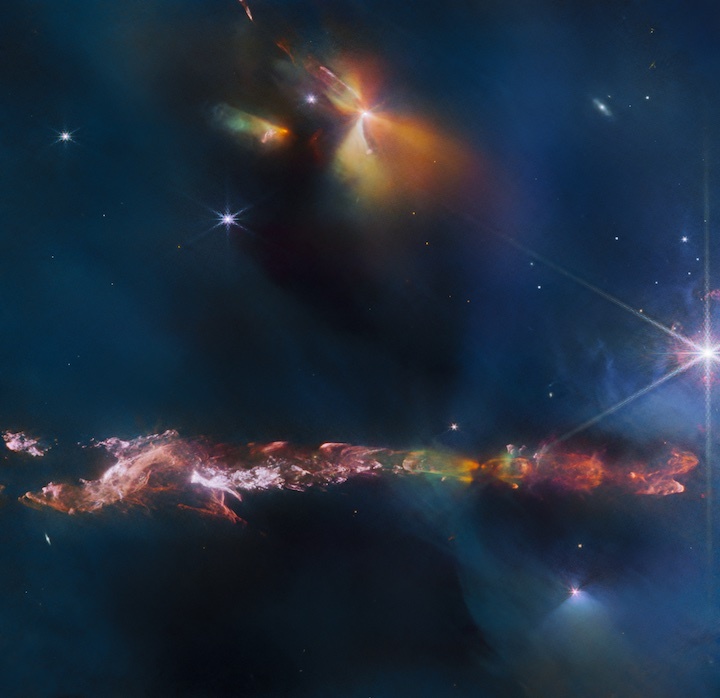
Using ground-based observations, researchers have previously found that for cold molecular gas associated with HH 797, most of the red-shifted gas (moving away from us) is found to the south (bottom right), while the blue-shifted gas (moving towards us) is to the north (bottom left). A gradient was also found across the outflow, such that at a given distance from the young central star, the velocity of the gas near the eastern edge of the jet is more red-shifted than that of the gas on the western edge. Astronomers in the past thought this was due to the outflow’s rotation. In this higher resolution Webb image, however, we can see that what was thought to be one outflow is in fact made up of two almost parallel outflows with their own separate series of shocks (which explains the velocity asymmetries). The source, located in the small dark region (bottom right of center), and already known from previous observations, is therefore not a single but a double star. Each star is producing its own dramatic outflow. Other outflows are also seen in this image, including one from the protostar in the top right of center along with its illuminated cavity walls.
HH 797 resides directly north of HH 211 (separated by approximately 30 arcseconds), which was the feature of a Webb image release in September 2023.
Quelle: ESA
----
Update: 2.12.2023
.
Webb Study Reveals Rocky Planets Can Form in Extreme Environments
An international team of astronomers has used NASA’s James Webb Space Telescope to provide the first observation of water and other molecules in the highly irradiated inner, rocky-planet-forming regions of a disk in one of the most extreme environments in our galaxy. These results suggest that the conditions for terrestrial planet formation can occur in a possible broader range of environments than previously thought.
Image: Protoplanetary Disk (Artist Concept)
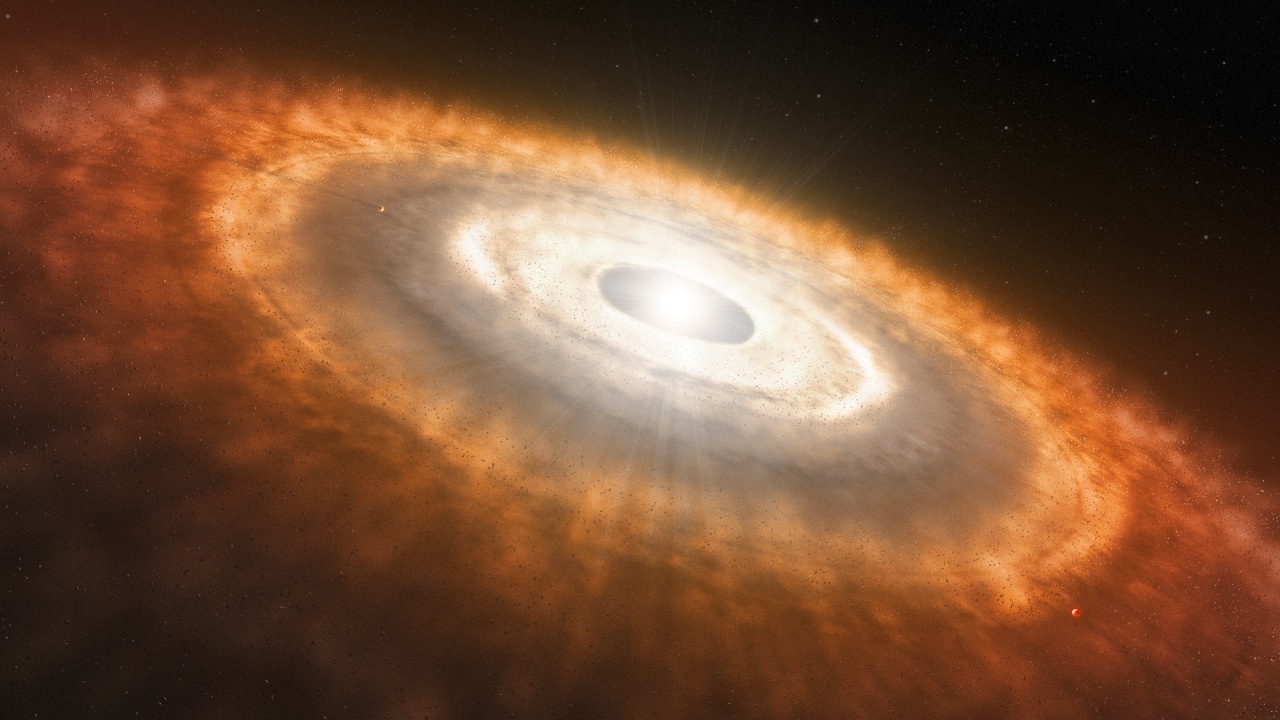
These are the first results from the eXtreme Ultraviolet Environments (XUE) James Webb Space Telescope program, which focuses on the characterization of planet-forming disks (vast, spinning clouds of gas, dust, and chunks of rock where planets form and evolve) in massive star-forming regions. These regions are likely representative of the environment in which most planetary systems formed. Understanding the impact of environment on planet formation is important for scientists to gain insights into the diversity of the different types of exoplanets.
The XUE program targets a total of 15 disks in three areas of the Lobster Nebula (also known as NGC 6357), a large emission nebula roughly 5,500 light-years away from Earth in the constellation Scorpius. The Lobster Nebula is one of the youngest and closest massive star-formation complexes, and is host to some of the most massive stars in our galaxy. Massive stars are hotter, and therefore emit more ultraviolet (UV) radiation. This can disperse the gas, making the expected disk lifetime as short as a million years. Thanks to Webb, astronomers can now study the effect of UV radiation on the inner rocky-planet forming regions of protoplanetary disks around stars like our Sun.
“Webb is the only telescope with the spatial resolution and sensitivity to study planet-forming disks in massive star-forming regions,” said team lead María Claudia Ramírez-Tannus of the Max Planck Institute for Astronomy in Germany.
Astronomers aim to characterize the physical properties and chemical composition of the rocky-planet-forming regions of disks in the Lobster Nebula using the Medium Resolution Spectrometer on Webb’s Mid-Infrared Instrument (MIRI). This first result focuses on the protoplanetary disk termed XUE 1, which is located in the star cluster Pismis 24.
“Only the MIRI wavelength range and spectral resolution allow us to probe the molecular inventory and physical conditions of the warm gas and dust where rocky planets form,” added team member Arjan Bik of Stockholm University in Sweden.
Image: XUE 1 spectrum detects water
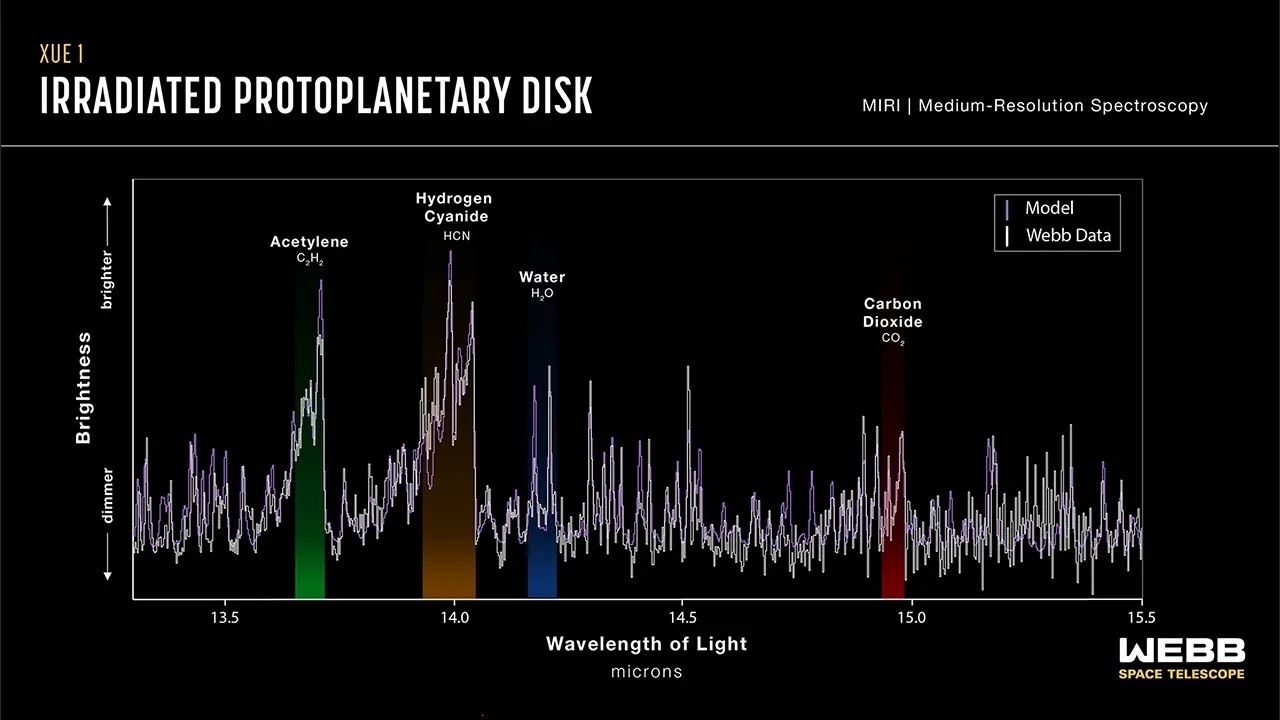
Due to its location near several massive stars in NGC 6357, scientists expect XUE 1 to have been constantly exposed to high amounts of ultraviolet radiation throughout its life. However, in this extreme environment the team still detected a range of molecules that are the building blocks for rocky planets.
“We find that the inner disk around XUE 1 is remarkably similar to those in nearby star-forming regions,” said team member Rens Waters of Radboud University in the Netherlands. “We’ve detected water and other molecules like carbon monoxide, carbon dioxide, hydrogen cyanide, and acetylene. However, the emission found was weaker than some models predicted. This might imply a small outer disk radius.”
“We were surprised and excited because this is the first time that these molecules have been detected under these extreme conditions,” added Lars Cuijpers of Radboud University. The team also found small, partially crystalline silicate dust at the disk’s surface. This is considered to be the building blocks of rocky planets.
These results are good news for rocky planet formation, as the science team finds that the conditions in the inner disk resemble those found in the well-studied disks located in nearby star-forming regions, where only low-mass stars form. This suggests that rocky planets can form in a much broader range of environments than previously believed.
Image: XUE 1 Spectrum detects CO
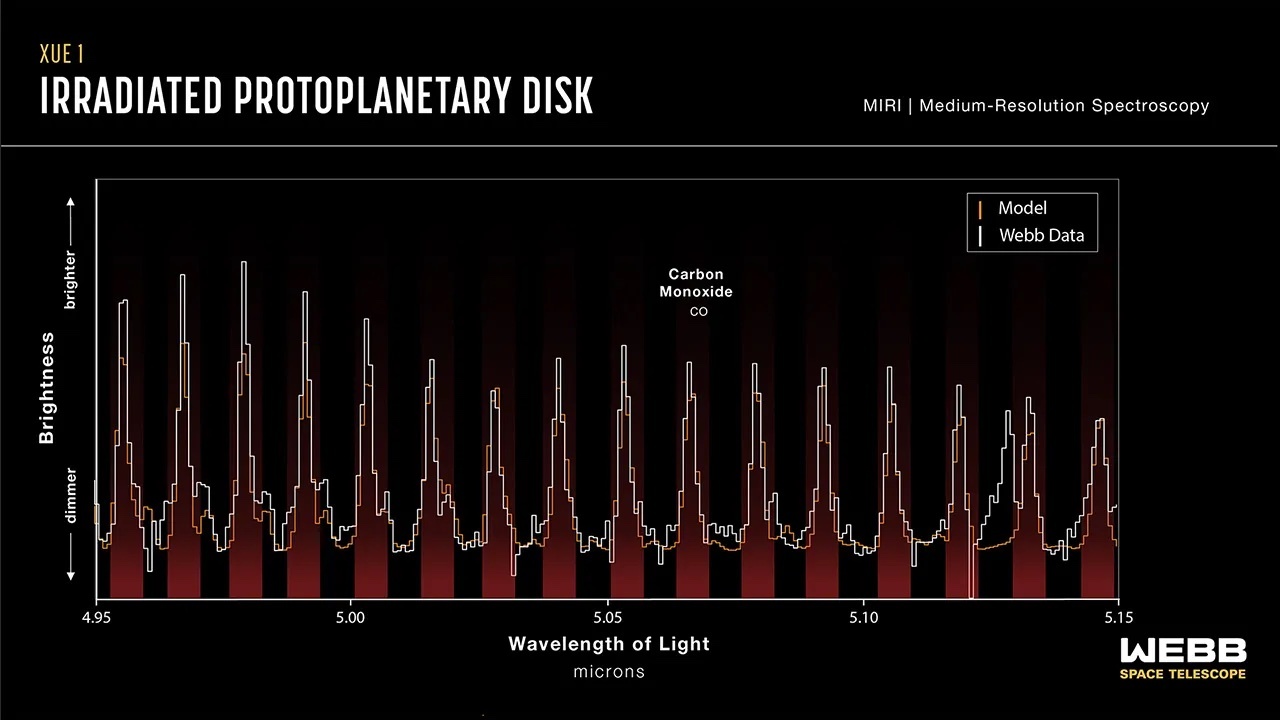
The team notes that the remaining observations from the XUE program are crucial to establish the commonality of these conditions.
“XUE 1 shows us that the conditions to form rocky planets are there, so the next step is to check how common that is,” said Ramírez-Tannus. “We will observe other disks in the same region to determine the frequency with which these conditions can be observed.”
These results have been published in The Astrophysical Journal.
Quelle: NASA
----
Update: 3.12.2023
.
Ghostlike dusty galaxy reappears in James Webb Space Telescope image
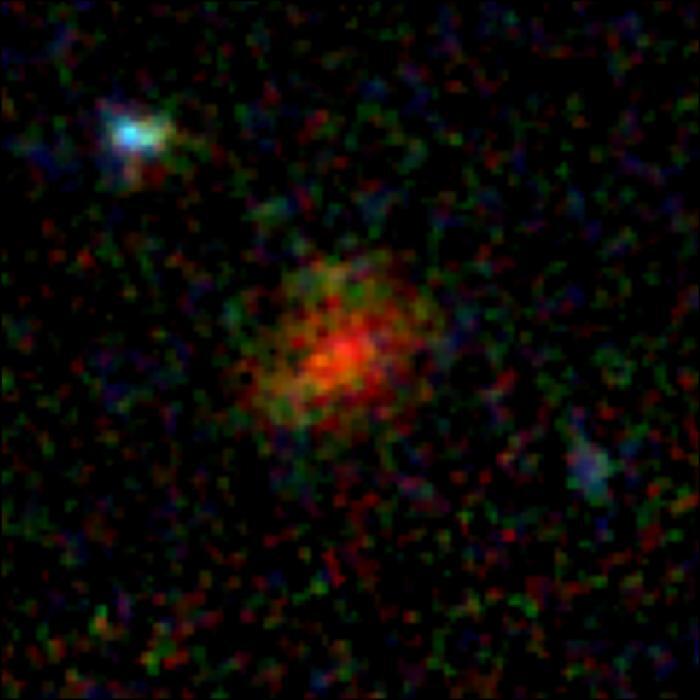
COLOR COMPOSITE OF GALAXY AZTECC71 FROM MULTIPLE COLOR FILTERS IN THE NIRCAM INSTRUMENT ON THE JAMES WEBB SPACE TELESCOPE. CREDIT: J. MCKINNEY/M. FRANCO/C. CASEY/UNIVERSITY OF TEXAS AT AUSTIN.
It first appeared as a glowing blob from ground-based telescopes and then vanished completely in images from the Hubble Space Telescope. Now, the ghostly object has reappeared as a faint, yet distinct galaxy in an image from the James Webb Space Telescope (JWST).
Astronomers with the COSMOS-Web collaboration have identified the object AzTECC71 as a dusty star-forming galaxy. Or, in other words, a galaxy that’s busy forming many new stars but is shrouded in a dusty veil that’s hard to see through — from nearly 1 billion years after the Big Bang. These galaxies were once thought to be extremely rare in the early universe, but this discovery, plus more than a dozen additional candidates in the first half of COSMOS-Web data that have yet to be described in the scientific literature, suggests they might be three to 10 times as common as expected.
“This thing is a real monster,” said Jed McKinney, a postdoctoral researcher at The University of Texas at Austin. “Even though it looks like a little blob, it’s actually forming hundreds of new stars every year. And the fact that even something that extreme is barely visible in the most sensitive imaging from our newest telescope is so exciting to me. It’s potentially telling us there’s a whole population of galaxies that have been hiding from us.”
If that conclusion is confirmed, it suggests the early universe was much dustier than previously thought.
The team published its findings in The Astrophysical Journal.
The COSMOS-Web project — the largest initial JWST research initiative, co-led by Caitlin Casey, an associate professor at UT Austin — aims to map up to 1 million galaxies from a part of the sky the size of three full moons. The goal in part is to study the earliest structures of the universe. The team of more than 50 researchers was awarded 250 hours of observing time in JWST’s first year and received a first batch of data in December 2022, with more coming in through January 2024.
A dusty star-forming galaxy is hard to see in optical light because much of the light from its stars is absorbed by a veil of dust and then re-emitted at redder (or longer) wavelengths. Before JWST, astronomers sometimes referred to them as “Hubble-dark galaxies,” in reference to the previously most-sensitive space telescope.
“Until now, the only way we’ve been able to see galaxies in the early universe is from an optical perspective with Hubble,” McKinney said. “That means our understanding of the history of galaxy evolution is biased because we’re only seeing the unobscured, less dusty galaxies.”
This galaxy, AzTECC71, was first detected as an indistinct blob of dust emission by a camera on the James Clerk Maxwell Telescope in Hawaii that sees in wavelengths between far infrared and microwave. The COSMOS-Web team next spotted the object in data collected by another team using the ALMA telescope in Chile, which has higher spatial resolution and can see in infrared. That allowed them to narrow down the location of the source. When they looked in the JWST data in the infrared at a wavelength of 4.44 microns, they found a faint galaxy in exactly the same place. In shorter wavelengths of light, below 2.7 microns, it was invisible.
Now, the team is working to uncover more of these JWST-faint galaxies.
“With JWST, we can study for the first time the optical and infrared properties of this heavily dust-obscured, hidden population of galaxies,” McKinney said, “because it’s so sensitive that not only can it stare back into the farthest reaches of the universe, but it can also pierce the thickest of dusty veils.”
The team estimates that the galaxy is being viewed at a redshift of about 6, which translates to about 900 million years after the Big Bang.
Study authors from UT Austin are McKinney, Casey, Olivia Cooper (a National Science Foundation graduate research fellow), Arianna Long (a NASA Hubble fellow), Hollis Akins and Maximilien Franco.
Support was provided by NASA through a grant from the Space Telescope Science Institute.
James Webb Space Telescope gazes into 'The Brick,' a dark nebula near the Milky Way's heart
Ice in a dark nebula found near the center of our galaxy is compounding the mystery of why this cloud isn't forming stars.
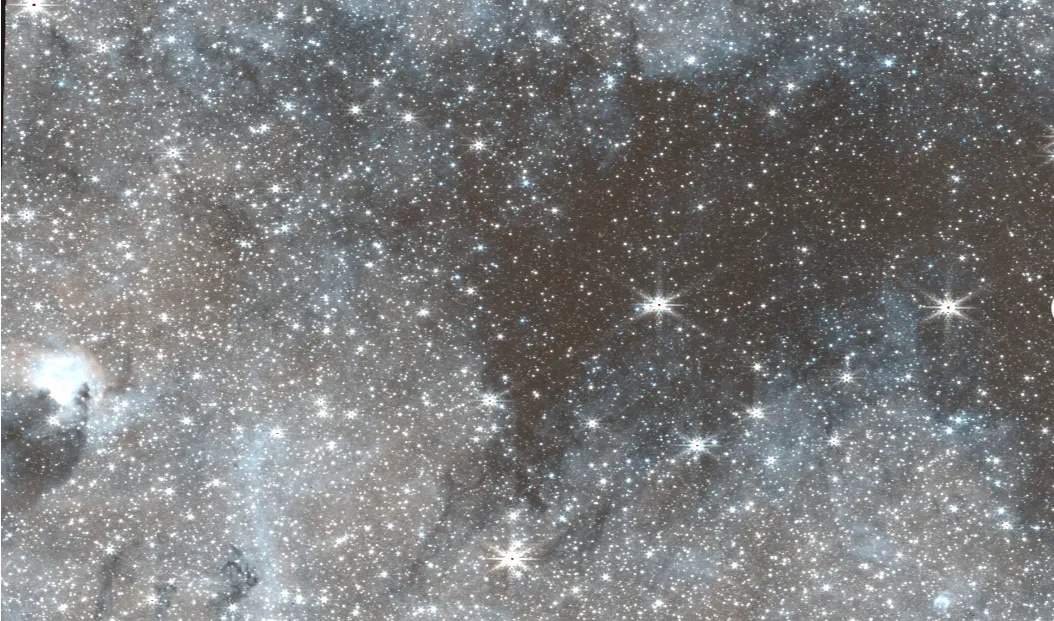
Bright regions in this image are where hydrogen is a hot plasma, glowing from the energy from the massive stars. The Brick is the dark region where that glowing plasma is blocked out. Along the edge of the Brick, the glow is bluer: this blue appearance is caused by the CO ice blocking out the red light, letting only the blue through. (Image credit: Adam Ginsburg)
The James Webb Space Telescope (JWST) has detected a substantial abundance of carbon-monoxide ice in a giant cloud of molecular gas, nicknamed "The Brick," that sits near the center of our Milky Way galaxy.
The Brick — which has a proper designation of G0.253+0.016 — resides in what astronomers refer to as the Central Molecular Zone, a huge agglomeration of nebulas totaling 60 million times the mass of our sun.
Many of these clouds are busy forming stars, but The Brick got its name because it is a dark slab set against the furnace of the Galactic Center. Why The Brick has yet to really start forming stars remains a mystery. One possible explanation is that it is a young cloud that hasn't had a chance to form stars yet; another is that gas within The Brick is too turbulent, or is being propped up and therefore prevented from collapsing by magnetic fields. It is such gaseous collapse that typically leads to star formation.
Now, the JWST has deepened the mystery even more. The spaceborne observatory has discovered a ton of carbon-monoxide ice in The Brick.
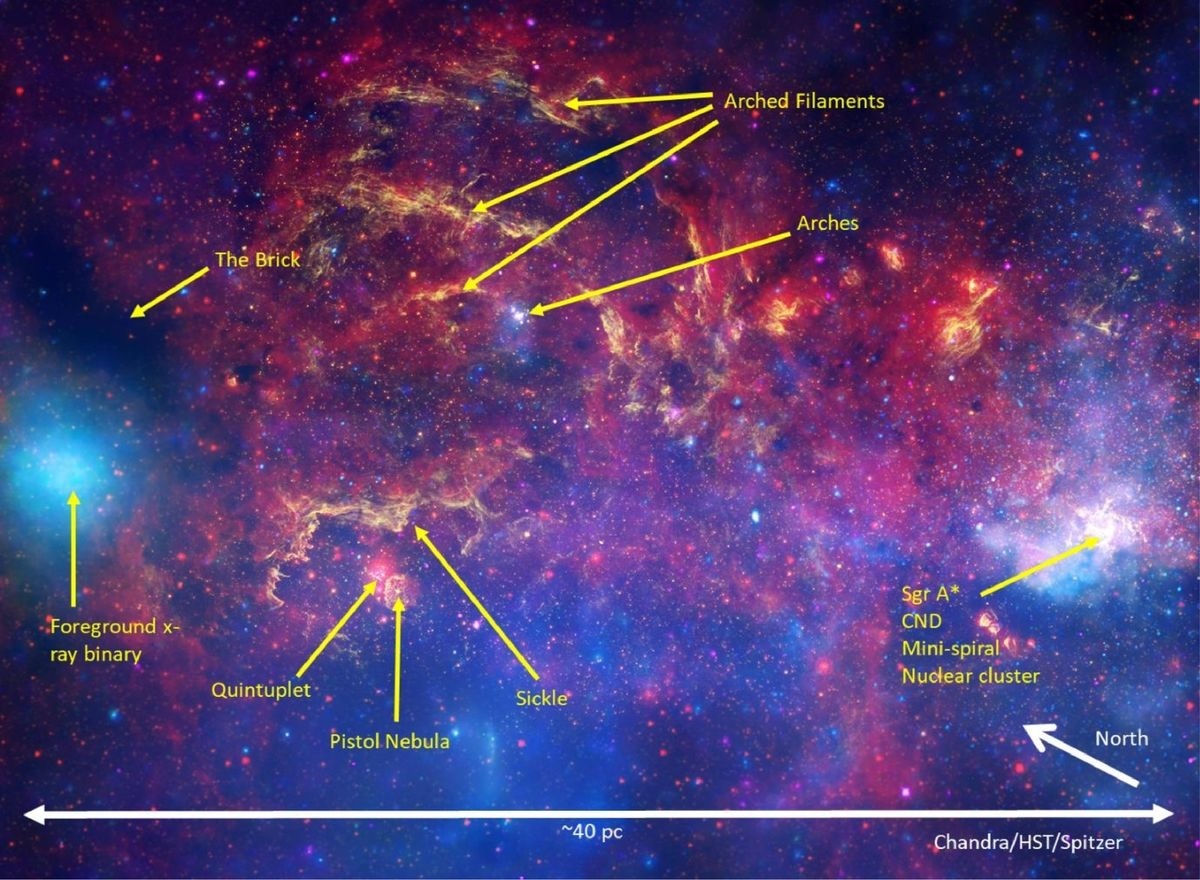
An image of the Central Molecular Zone, with several features labeled, including The Brick. (Image credit: NASA/Chandra/HST/ESA/STScI/Q. D. Wang/Spitzer/Churchwell et al.)
Carbon-monoxide ice has been detected in the Galactic Center before, condensing on particles of dust, but it is generally difficult to detect in the interstellar medium. Therefore, no one really knew how much ice is in the nebulas at the center of the galaxy. That's why astronomers led by Adam Ginsburg of the University of Florida were surprised when the JWST's Near-Infrared Camera (NIRCam) detected so much of the substance.
"Our observations compellingly demonstrate that ice is very prevalent there, to the point that every observation in the future must take it into account," said Ginsburg in a statement.
Star formation requires very cold conditions to begin, with molecular gas plunging to temperatures as low as ten degrees above absolute zero. Absolute zero, for context, is the lowest possible temperature in the universe. However, despite the ice's abundance, the JWST measured that gas in The Brick is surprisingly warm compared to other molecular clouds.
The next step, the team says, is to use the JWST to discover what other ices are to be found in The Brick and other nearby nebulas in the Galactic Center.
"We don't know, for example, the relative amounts of carbon monoxide, water and carbon dioxide, and complex molecules," said Ginsburg. "With spectroscopy, we can measure those and get some sense of how chemistry progresses over time in these clouds."
Studying the center of our galaxy may have cosmological repercussions. Star-forming conditions in general in the Galactic Center are thought to be our closest mirror of the star-forming conditions in the early universe. Some theories also suggest supermassive black holes were born from the gravitational collapse of extremely massive molecular clouds. However, one spanner in the works of this theory has always been the mystery of what prevented the collapsing clouds from fragmenting and forming lots of stars rather than one black hole. Clues to the answers might be found in the opaque confines of nebulas like The Brick.
The new findings were published on the Dec. 4 in The Astrophysical Journal. A preprint is available here.
Quelle: SC
----
Update: 9.12.2023
.
Webb Space Telescope Celebrates Two Years of Stunning Observations
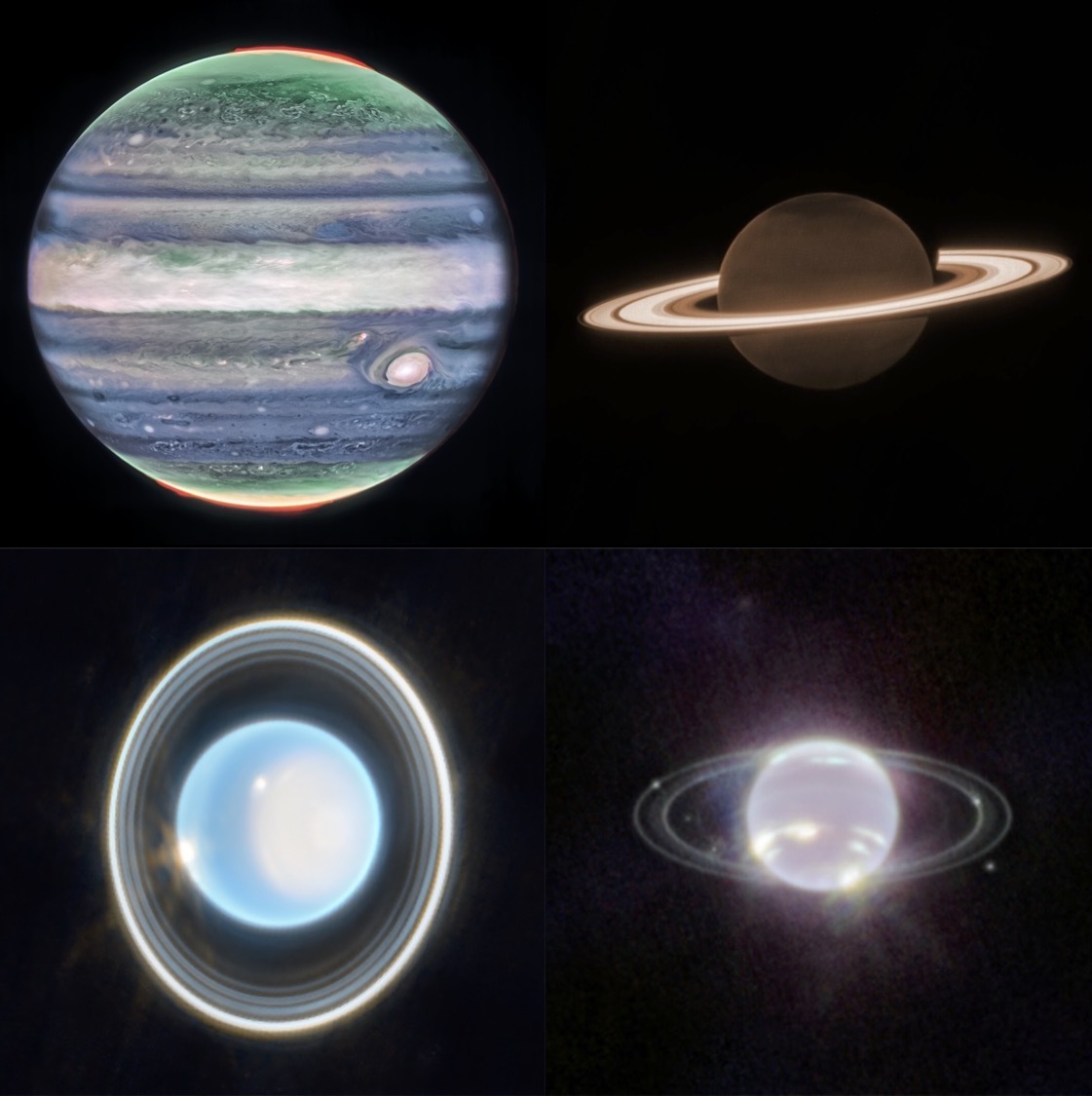
Readers who are not satisfied with one planet should try looking at four! Neptune (bottom right) was studied by Webb in 2022. However, the observatory trained its gaze on the other three giant planets (Jupiter, Saturn, and Uranus) for the first time this year. This will be an annual task for Webb. With the exception of Jupiter, the outer planets are not currently being studied by spacecraft. Therefore, telescopic observations provide the only feasible means to track changes in their atmospheres. Our knowledge of Uranus and Neptune, in particular, is limited. Close-range observations of these planets are limited to data from Voyager 2, which conducted brief flybys of the ice giants in 1986 and 1989, respectively. Again, Webb’s infrared vision is useful, as it is able to detect pale yet warm clouds and storm systems in the planets’ atmospheres.
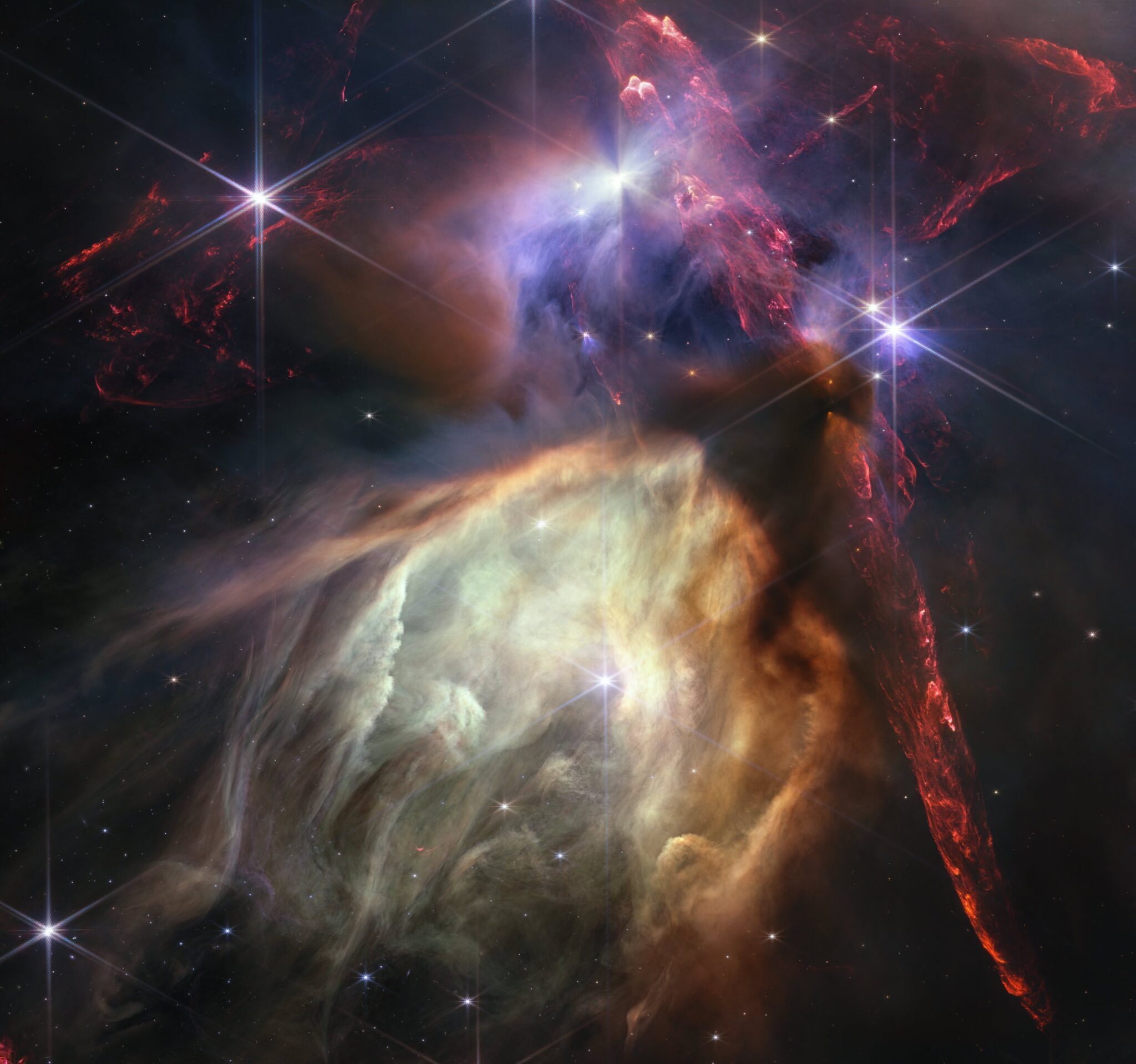
Webb also studies the opposite end of the stellar lifecycle. Stars are created in massive, glowing nebulae. Gas and dust are concentrated in these stellar nurseries. Swirling accumulations of this material can become sufficiently large for gravitational forces to draw in surrounding material, driving a positive feedback loop (“snowball effect”). If they become large enough to fuse hydrogen into helium and produce light, these accumulations of gas turn into stars. To celebrate its first year of scientific observations, Webb imaged this particularly beautiful nebula. Known as Rio Ophiuchi, it is the closest star-forming nebula to Earth. This scene contains approximately 50 newborn stars, many of which likely have planetary systems
Quelle: AS
----
Update: 12.12.2023
.
NASA’s Webb Stuns With New High-Definition Look at Exploded Star
Mysterious features hide in near-infrared light
Like a shiny, round ornament ready to be placed in the perfect spot on a holiday tree, supernova remnant Cassiopeia A (Cas A) gleams in a new image from NASA’s James Webb Space Telescope. As part of the 2023 Holidays at the White House, First Lady of the United States Dr. Jill Biden debuted the first-ever White House Advent Calendar. To showcase the “Magic, Wonder, and Joy” of the holiday season, Dr. Biden and NASA are celebrating with this new image from Webb.
While all is bright, this scene is no proverbial silent night. Webb’s NIRCam (Near-Infrared Camera) view of Cas A displays this stellar explosion at a resolution previously unreachable at these wavelengths. This high-resolution look unveils intricate details of the expanding shell of material slamming into the gas shed by the star before it exploded.
Cas A is one of the most well-studied supernova remnants in all of the cosmos. Over the years, ground-based and space-based observatories, including NASA’s Chandra X-Ray Observatory, Hubble Space Telescope, and retired Spitzer Space Telescope have assembled a multiwavelength picture of the object’s remnant.
However, astronomers have now entered a new era in the study of Cas A. In April 2023, Webb’s MIRI (Mid-Infrared Instrument) started this chapter, revealing new and unexpected features within the inner shell of the supernova remnant. Many of those features are invisible in the new NIRCam image, and astronomers are investigating why.
Image: Cassiopeia A (NIRCam)
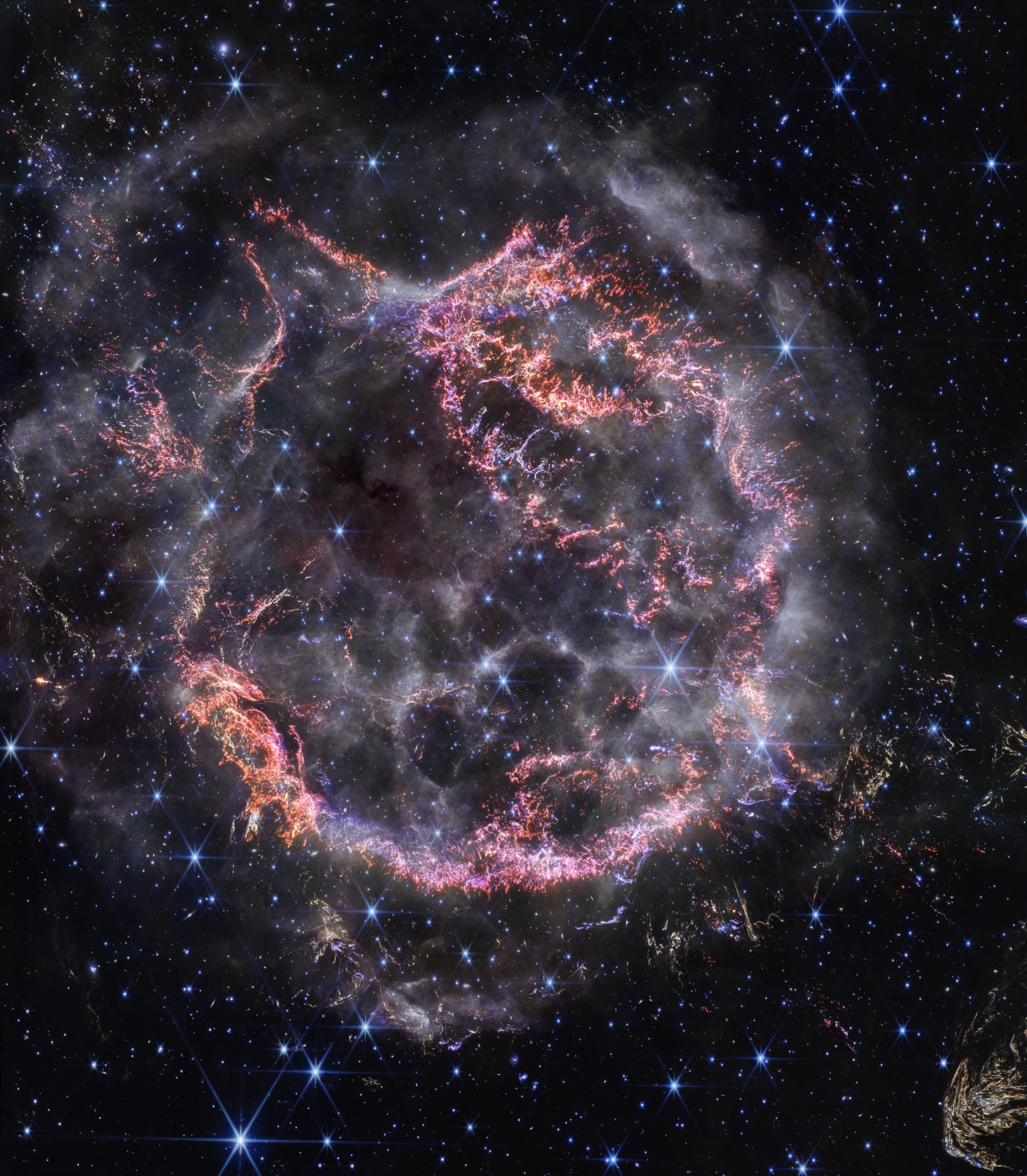
‘Like Shards of Glass’
Infrared light is invisible to our eyes, so image processors and scientists translate these wavelengths of light to visible colors. In this newest image of Cas A, colors were assigned to different filters from NIRCam, and each of those colors hints at different activity occurring within the object.
At first glance, the NIRCam image may appear less colorful than the MIRI image. However, this simply comes down to the wavelengths in which the material from the object is emitting its light.
The most noticeable colors in Webb’s newest image are clumps represented in bright orange and light pink that make up the inner shell of the supernova remnant. Webb’s razor-sharp view can detect the tiniest knots of gas, comprised of sulfur, oxygen, argon, and neon from the star itself. Embedded in this gas is a mixture of dust and molecules, which will eventually become components of new stars and planetary systems. Some filaments of debris are too tiny to be resolved by even Webb, meaning they are comparable to or less than 10 billion miles across (around 100 astronomical units). In comparison, the entirety of Cas A spans 10 light-years across, or 60 trillion miles.
“With NIRCam’s resolution, we can now see how the dying star absolutely shattered when it exploded, leaving filaments akin to tiny shards of glass behind,” said Danny Milisavljevic of Purdue University, who leads the research team. “It’s really unbelievable after all these years studying Cas A to now resolve those details, which are providing us with transformational insight into how this star exploded.”
Image: Cassiopeia A NIRCam/MIRI
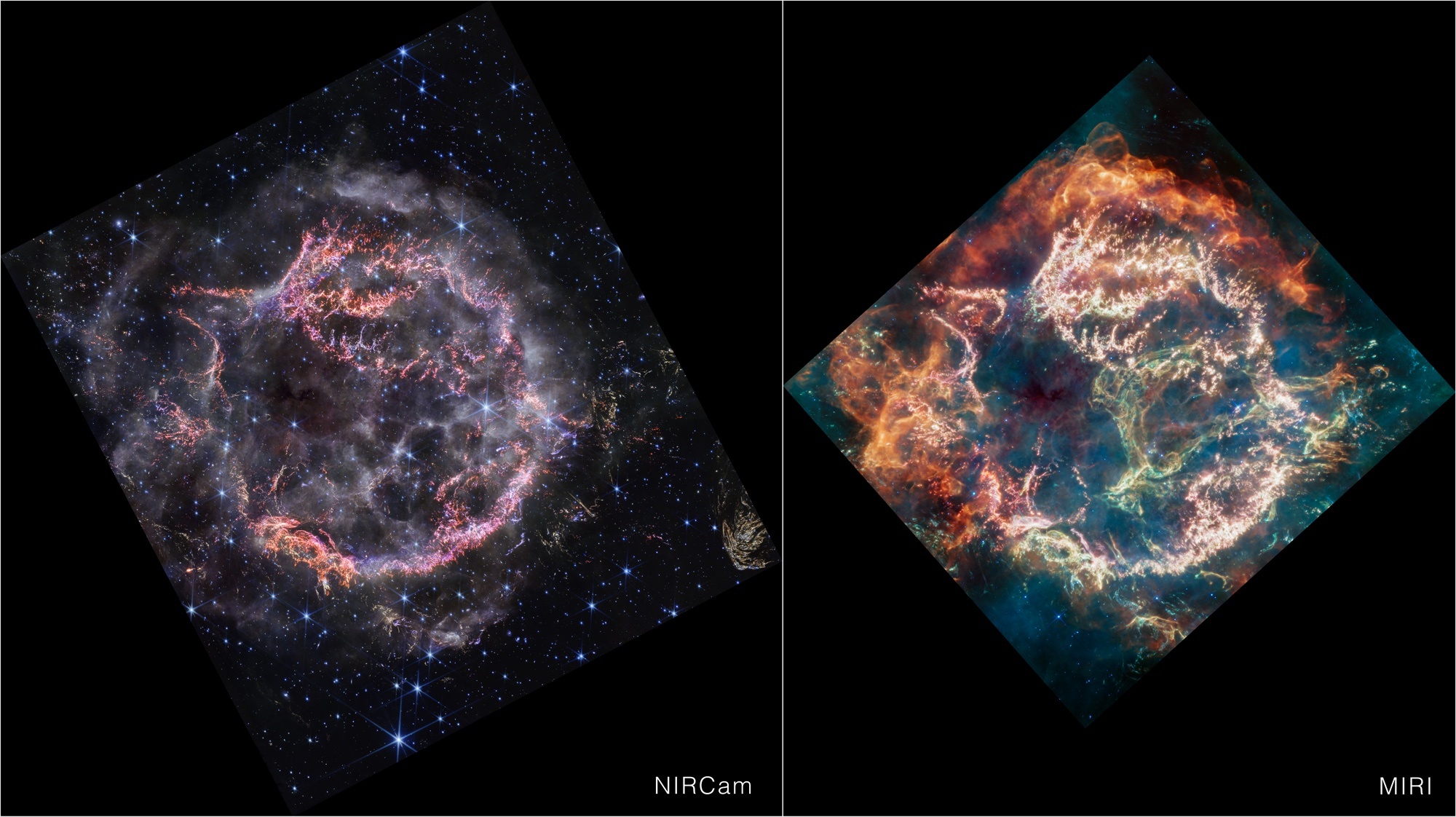
Hidden Green Monster
When comparing Webb’s new near-infrared view of Cas A with the mid-infrared view, its inner cavity and outermost shell are curiously devoid of color.
The outskirts of the main inner shell, which appeared as a deep orange and red in the MIRI image, now look like smoke from a campfire. This marks where the supernova blast wave is ramming into surrounding circumstellar material. The dust in the circumstellar material is too cool to be detected directly at near-infrared wavelengths, but lights up in the mid-infrared.
Researchers say the white color is light from synchrotron radiation, which is emitted across the electromagnetic spectrum, including the near-infrared. It’s generated by charged particles traveling at extremely high speeds spiraling around magnetic field lines. Synchrotron radiation is also visible in the bubble-like shells in the lower half of the inner cavity.
Also not seen in the near-infrared view is the loop of green light in the central cavity of Cas A that glowed in mid-infrared, nicknamed the Green Monster by the research team. This feature was described as “challenging to understand” by researchers at the time of their first look.
While the ‘green’ of the Green Monster is not visible in NIRCam, what’s left over in the near-infrared in that region can provide insight into the mysterious feature. The circular holes visible in the MIRI image are faintly outlined in white and purple emission in the NIRCam image – this represents ionized gas. Researchers believe this is due to the supernova debris pushing through and sculpting gas left behind by the star before it exploded.
Image: Cassiopeia A Features
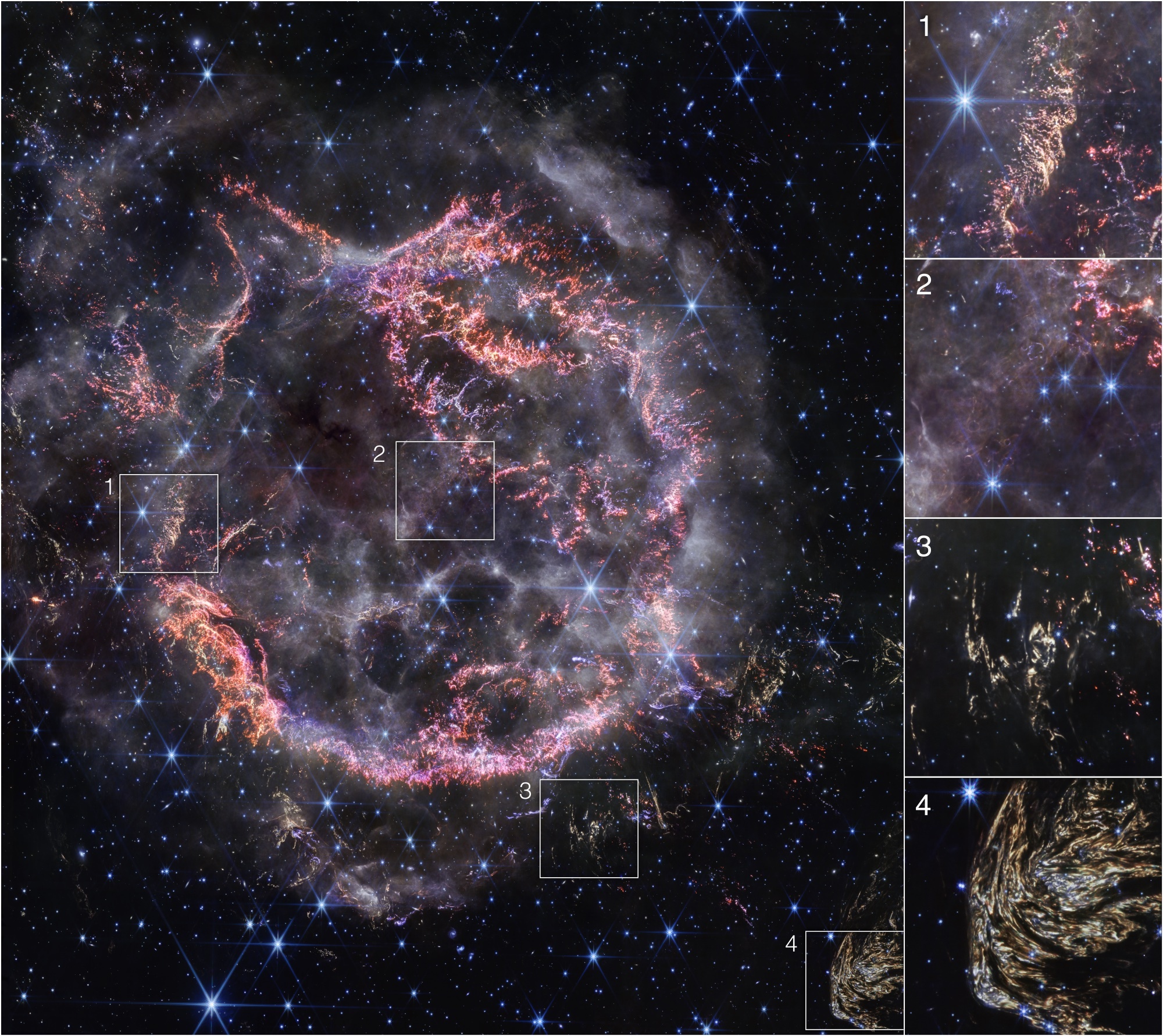
Baby Cas A
Researchers were also absolutely stunned by one fascinating feature at the bottom right corner of NIRCam’s field of view. They’re calling that large, striated blob Baby Cas A – because it appears like an offspring of the main supernova.
This is a light echo, where light from the star’s long-ago explosion has reached and is warming distant dust, which is glowing as it cools down. The intricacy of the dust pattern, and Baby Cas A’s apparent proximity to Cas A itself, are particularly intriguing to researchers. In actuality, Baby Cas A is located about 170 light-years behind the supernova remnant.
There are also several other, smaller light echoes scattered throughout Webb’s new portrait.
The Cas A supernova remnant is located 11,000 light-years away in the constellation Cassiopeia. It’s estimated to have exploded about 340 years ago from our point of view.
The James Webb Space Telescope is the world’s premier space science observatory. Webb is solving mysteries in our solar system, looking beyond to distant worlds around other stars, and probing the mysterious structures and origins of our universe and our place in it. Webb is an international program led by NASA with its partners, ESA (European Space Agency) and the Canadian Space Agency.
Quelle: NASA
